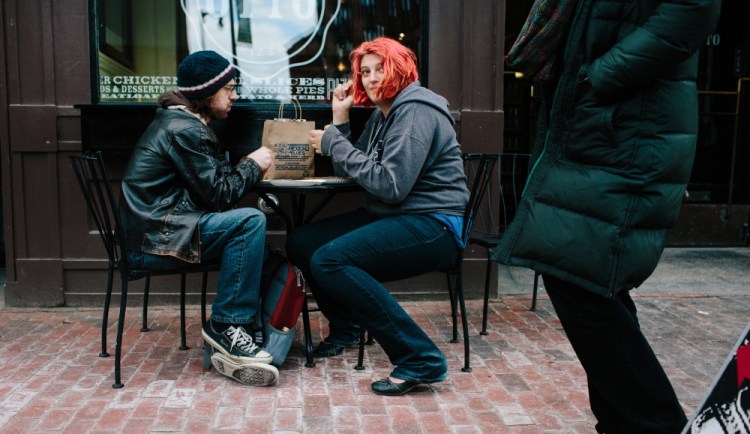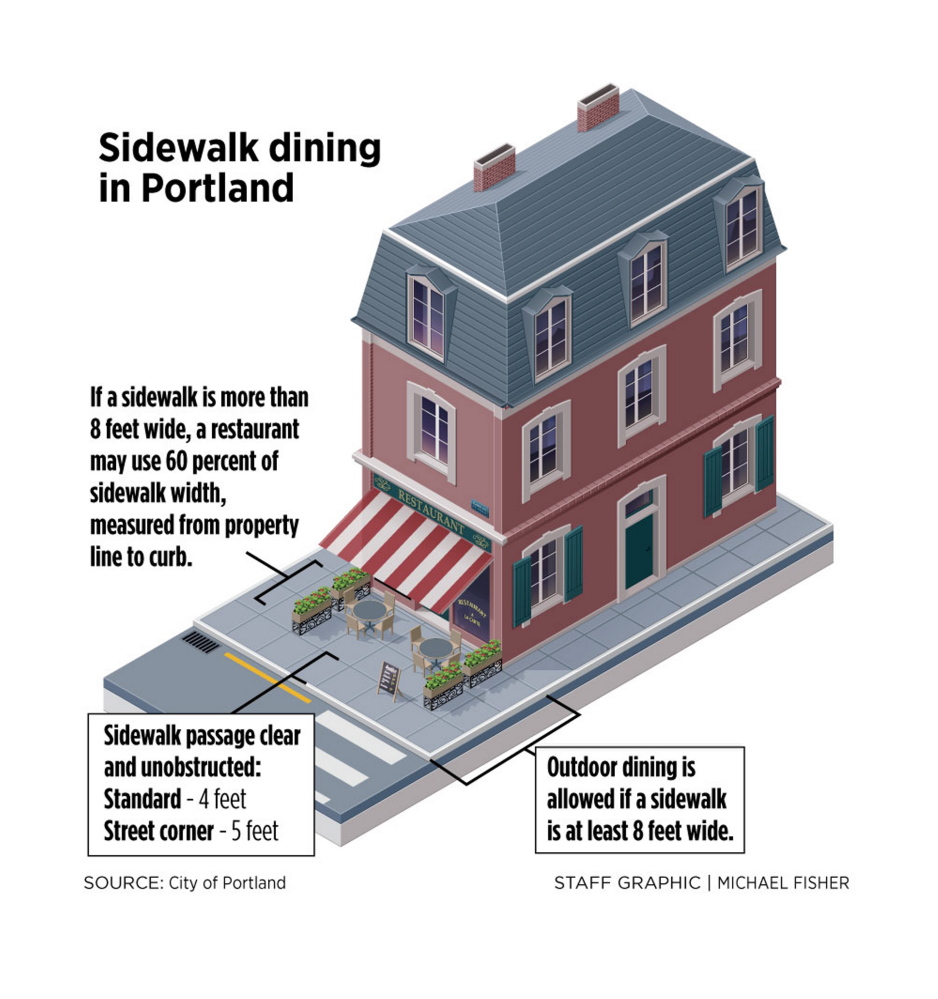The city of Portland for the first time is spelling out specific rules for restaurants with outdoor dining, including how much sidewalk space they can take and the times of year patrons can sit outside.
The city revised its guidelines after receiving complaints from parents pushing strollers, people in wheelchairs and others with mobility requirements who said dining spaces were encroaching on pedestrian walkways.
The permit application that restaurants must submit to apply for outdoor seating spells out clear measurements for how much sidewalk space their tables and chairs can take up, and how many feet of pedestrian space must be maintained.
For restaurants without sidewalks wide enough to support outdoor dining, businesses can request to use a parking space, or appeal to planners for an exemption.
“We’re trying to best balance the need to maintain public, accessible sidewalks with our desire to have an active street cafe culture,” Caitlin Cameron, urban designer for the city, said in a statement. She said the new regulations will help achieve that “by providing clarity and consistency.”
Last year, the city received 20 complaints against restaurants whose outdoor dining areas were taking up too much of the sidewalk or were encumbering pedestrians.
The revised requirements came after complaints from people who noted that people pushing strollers and people with disabilities were forced to navigate around outdoor dining areas that crept onto more of the sidewalk as the alfresco season progressed. The city in November sought input from restaurant owners on the proposed regulations.
Renee Berry-Huffman, who co-chairs the city’s Disabilities Advisory Committee and helped push for the rules changes, said she believes the city has been adequately responsive to the problems.
“Nothing is going to happen in a blink of an eye,” said Berry-Huffman, who uses a power wheelchair to get around. “I think there was forward-thinking discussion involved in this, and I think diverse views were brought into play, and I’m really proud that this was the result of that.”
Under the guidelines, restaurants must have a sidewalk at least 8 feet wide, and a clear 4-foot-wide passage for pedestrians must be maintained at all times.
For restaurants with sidewalks wider than 8 feet, dining areas can take up no more than 60 percent of the width of the sidewalk.
The rules also specify the barriers used to mark off a dining area.
The city prefers that restaurants use rope or chain stanchions that are free-standing, not attached to a building. Fencing or other solid barriers must be 50 percent open, or visually transparent. Solid or opaque barriers are barred, as are any structures exceeding 42 inches in height or ones that display commercial signs.
Outdoor dining season is for the first time also defined in the new regulations as running from April 1 to Nov. 15.
Of particular value to people with disabilities is the possibility for a restaurant to effectively rent a city parking space if the sidewalk outside its business is too narrow to support outdoor seating, Berry-Huffman said.
“People with disabilities are also potential customers,” Berry-Huffman said. “The disabled dollar is just as good as the non-disabled dollar.”
One restaurateur, Tom Barr, who owns Taco Escobarr at 548 Congress St., said he went out Friday afternoon with a yardstick to make sure his outdoor seating space would be in compliance.
Barr said he built in a few extra feet of clearance around his 15-by-10-foot outside dining area last year. He expects the setup to fit almost perfectly within the new guidelines.
For the $380 outdoor seating permit, Barr said he can host 12 people outdoors, which over the 7½-month outdoor season is a bargain, as he has only about 40 seats indoors. That seasonal increase in seating capacity means a serious revenue boost, he said.
“I didn’t get the impression that anything was particularly unfair, especially if they’re willing to work with people on it,” Barr said. “I’m going to see if the city can move a planter for me, so it’s easier for people to pass by.”
The $80 base permit fee will remain the same, with an additional $2 per square foot of dining area on sidewalks, and $6 per square foot in city parks, due annually.
In 2014, 58 restaurants in Portland were granted outdoor seating permits, bringing in $1,256 in permit fees. As of Friday, 24 restaurants had applied, with five of them already approved.
Send questions/comments to the editors.





Success. Please wait for the page to reload. If the page does not reload within 5 seconds, please refresh the page.
Enter your email and password to access comments.
Hi, to comment on stories you must . This profile is in addition to your subscription and website login.
Already have a commenting profile? .
Invalid username/password.
Please check your email to confirm and complete your registration.
Only subscribers are eligible to post comments. Please subscribe or login first for digital access. Here’s why.
Use the form below to reset your password. When you've submitted your account email, we will send an email with a reset code.